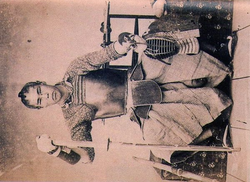
Kendo in History
It is a difficult task indeed to define the exact origins of Kendo as Kendo was not created or developed by a single person or even a group of people at any particular period in time. What can be said of Kendo’s history is this: Around 200 B.C.E the sword amongst other things was introduced to the islands of Japan by various emigrating Chinese and Korean ethnic groups that intermingled with the native Jomon population. By 700 C.E, the art of sword-smithing had taken root in Japanese culture and thus began being domestically produced. After the 9th century, as the bushi / samurai class was established, the progenator of the Nihonto was developed. This sword differed from its Chinese predecessor in that it had a curved blade rather than a rigid straight one. As Japan entered into the 14th century it was engulfed in civil war. The Nihonto soon became the weapons of choice among the warrior class replacing older sword styles and the Japanese Long Bow (Yuri). During these years of perpetual war, Japan saw the rise of many different schools of kenjutsu. These schools were each created by various master swordsmen, and each school had its own style unique to the originator. As the civil war drew to a close and more peaceful times prevailed, more emphasis was placed on the spiritual aspects of kenjutsu training. These moral and social aspects stemmed from Zen Buddhism, bushido, and Confucianism. During the mid-18th century before the Meji restoration period, protective equipment was developed and popularised within kenjutsu circles.
 |  |  |
|---|---|---|
 |  |  |
 |
These developments in protective equipment and the usage of shinai (a mock sword made of four bamboo slats bound together) played an important role in the popularization of kenjutsu. In the last days of the Tokugawa Shogunate, awareness for the need of national defence was on the rise and the modified Kenjutsu that included protective armour became popular among many non-bushi class citizens. After the fall of the shogunate and the rise of the Meji Era in 1867, modern Japan was established and the Bushi class was dismantled. The right to wear the traditional Daisho or two swords, symbolic of the Samurai class, in public was abolished. Kenjutsu suffered a momentary decline in practice and popularity. However, in the late 1870's kenjutsu was once again revived to train the Tokyo police in the ways of old as a means to restore Japanese pride in their ancient heritage. However, the popularization of kenjutsu demanded a universal form, one that would integrate all the different existing schools of the art. In 1912, after a long deliberation among masters from major ryu, a new system of kenjutsu was developed. This was dubbed kendo to differentiate the intent of the art. Kenjutsu aimed at defeating the opponent whereas kendo aims at self-cultivation. Shortly after the Second World War the allied occupation of Japan saw Kendo as a means of inciting ultranationalism amongst the people and was thusly banned and faced near extinction.
Kendo in Modernity
Literally translated, Kendo or 剣道 means "the way of the sword." It is a traditional Japanese sword art that was originally developed and practised by the bushi or samurai class of feudal Japan. Modern kendo originates from the various schools of sword fighting techniques developed over many centuries of combat and study. The goal of kendo is not only to develop the physical ability for fighting, but also the moral and spiritual aspects of rigorous and disciplined training. Or in other words Kendo is a way through which it is possible to discipline and cultivate the human character through the application of the principles of the katana. The kendo we know and see today came to be aproximatly 7 years after the end of the Second World War when The All Japan Kendo Federation (AJKF or ZNKR) was founded. Immediately after Japan's independence was restored the ban on martial arts in Japan was lifted, thus bringing Kendo out of its state of hibernation. The AJKF was formed on the principle of kendo being not a martial art per se but more so as educational sport and it has continued to be practiced as such to this day while still retaining its status of being a martial art. Today Kendo is practiced in many countries around the world and is said to have more than 2.5 million practitioners worldwide.
 |  |  |
|---|---|---|
 |  |  |
